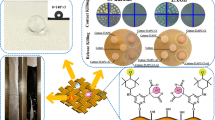Abstract
Halamine structures incorporated on polyester/cotton fabrics were able to detoxify oxime carbamate pesticides that contain thio bonds rapidly upon contact. The reaction was endothermic, and the detoxification rate was in first order to concentrations of the pesticides. Aldicarb was degraded in a much faster rate than that of methomyl by the halamine fabrics. The reactivity of halamine structures was different, and imide halamine was more reactive than amine halamine. The detoxification was an oxidative reaction on the sulfur atom existing in both aldicarb and methomyl. The same halamine structures were unable to effectively react with carbaryl and carbofuran, which are aromatic carbamates and do not contain any thio bonds.







Similar content being viewed by others
References
Bogoczek R, Kociolek-Balawejder E (1991) N-bromo-poly(styrene-co-divinylbenzene) sulfonamide metal salts. Synthesis and basic properties. Angewandte Makromol Chem 188:85–96
Csiszar E, Borsa J, Racz IK, Obendorf SK (1998) Reduction in human exposure to pesticide using traditional work clothing fabrics with chemical finishing: carboxymethylation and starch. Arch Environ Contam Toxicol 35:129–134
Iowa State University Cover Up With Coveralls And Aprons, Safe Farm, January 1995
Ko LL, Shibamoto T, Sun G (2000) A novel detoxifying pesticide protective clothing for agricultural workers. Textile Chem Color Am Dyestuff Rep 32:34–38
Mason Y, Choshen E, Rav-Acha C (1990) Carbamate insecticides: removal from water by chlorination and ozonation. Water Res 24:11–21
Miles CJ, Trehy ML, Yost RA (1988) Degradation of N-methylcarbamate and carbamoyl oxime pesticides in chlorinated water. Bull Environ Contam Toxicol 41:838–843
Miles CJ, Oshiro WC (1990) Degradation of methomyl in chlorinated water. Environ Toxicol Chem 9:535–540
Obendorf SK, Kasunick RS, Ravichandran V, Borsa J, Coffman CW (1991) Starch as a renewable finish to improve the pesticide-protective properties of conventional workclothes. Arch Environ Contam Toxicol 21:10–16
Qian L, Sun G (2003) Durable and regenerable antimicrobial textiles: Synthesis and applications of 3-methylol-2,2,5,5-tetramethyl-imidazolidin-4-one (MTMIO). J Appl Polymer Sci 89:2418–2425
Qian L, Sun G (2004) Durable and regenerable antimicrobial textiles: Improving efficacy and durability of biocidal functions. J Appl Polymer Sci 91:2588–2593
Sato T, Schulz RC (1979) Oxidation of tertiary amines with N-chloronylon 66. Makromol Chem 180:299–305
Sun G, Worley SD (1997) Oxidation of secondary alcohols and sulfides by halamine polymers. Chem Oxid 6:134–144
Takemoto K, Ottenbrite RM, Kamachi M, Decler M (1997) Functional monomers and polymers, 2nd ed. Marcel Dekker, New York
WHO (1986) Environmental Health Criteria 63 and 64. (Carbamate) Insecticides: A General Introduction. World Health Organization, Geneva
Zhang X, Raheel M (2003) Statistical model for predicting pesticide penetration in woven fabrics used for chemical protective clothing. Bull Environ Contam Toxicol 70:652–659
Acknowledgments
The authors are grateful to financial support from the National Science Foundation (DMI 9733981), the National Textile Center (C02-CD06) and the National Personal Protective Technology Laboratory (03NPTTB-041).
Author information
Authors and Affiliations
Corresponding author
Rights and permissions
About this article
Cite this article
Fei, X., Gao, P., Shibamoto, T. et al. Pesticide Detoxifying Functions of N-Halamine Fabrics. Arch Environ Contam Toxicol 51, 509–514 (2006). https://doi.org/10.1007/s00244-005-0175-8
Received:
Accepted:
Published:
Issue Date:
DOI: https://doi.org/10.1007/s00244-005-0175-8




